Example Article: Why Airplanes MUST Be Washed Every 7 Days on Aircraft Carriers
Clean aircraft save money.
Clean aircraft save money. This may seem like a simple statement, but the reasons behind it are numerous and significant. Both the interior and exterior of aircraft need to be cleaned frequently for various reasons, including safety, appearance, fuel savings, and maintenance.
On the inside of an aircraft, cleanliness is crucial for the health and comfort of passengers. However, it is often neglected, with only a small team of cleaners given a short amount of time between flights to clean up trash, wipe down surfaces, and vacuum the aisles. This can lead to unsanitary conditions, with seatback pockets becoming a breeding ground for all sorts of garbage, including used tissues and even used diapers. Cleaning the interior of an aircraft is not only important for the health and comfort of passengers, but also for safety reasons. It is hard to inspect aircraft parts for cracks and damages when they are covered in dirt, and keeping components clean can improve their lifespan, reducing costs in the long term.
On the outside of an aircraft, appearance is important for inspiring confidence in passengers that the aircraft is safe to fly. A dirty aircraft can be a turn-off for potential customers, leading to lower ticket sales. However, there are also significant fuel savings to be had from cleaning the exterior of an aircraft. Dirt and grime on the skin of an aircraft can produce drag and disturb the airflow, leading to increased fuel consumption. Cleaning the exterior of an aircraft can lead to up to 2% in fuel savings, which can save airlines a significant amount of money in the long term. Additionally, keeping aircraft components clean can improve their lifespan, reducing costs in the long term.
For the military, there are additional reasons for keeping aircraft clean. Corrosion prevention is a key concern, especially in sandy and saltwater environments. Washing aircraft frequently can help prevent corrosion, reducing maintenance costs in the long term.
Cleaning aircraft is not a simple or easy task. The traditional cleaning process of a Boeing 737 takes 5 people and close to 7 hours, while washing a Boeing 777 or larger aircraft will take an entire shift with at least 10 people. The larger the aircraft, the harder it is to clean, requiring specialized equipment and dedicated teams. However, the benefits of clean aircraft are significant, leading to improved safety, appearance, fuel savings, and maintenance.
In conclusion, clean aircraft save money. While it may seem like a minor detail, the cleanliness of both the interior and exterior of an aircraft can have significant financial implications for airlines and the military. By investing in regular cleaning and maintenance, these organizations can save money in the long term, while also improving the health, safety, and comfort of passengers.
Robotic aircraft washing saves time and water.
One area where technology is making a significant impact on aircraft cleaning is in the use of robotic washing systems. These systems offer significant advantages over traditional manual methods, including reduced water consumption and shorter cleaning times.
Depending on the wash type and cleaning chemicals used, certain parts of the aircraft must be sealed prior to the wash. All important sensors are also covered. The rinsing begins, followed by lots of scraping with soapy water. Then, it's rinsed off, all the tape is removed, and inspectors make sure no soap is left behind. This process is time-consuming and requires a lot of water.
Each aircraft wash requires enormous amounts of water, and for this reason, many airlines prefer a dry wash, which relies on chemicals. During the dry wash process, a special cleaning solution is applied to the aircraft's skin, which typically looks like a mist of foam. The cleaning solution is left on the skin of the aircraft for a short period of time so it can penetrate the dirt and bind with it. Afterward, the cleaning solution is wiped or brushed off along with the encapsulated dirt and contaminants.
Introducing Nordic Dino, the ultimate cleaning beast. This semi-automatic washing robot takes orders from a remote control, like a dog trained to scrub. It doesn't discriminate between narrow or wide body aircraft. It's ready to tackle any dirty monster in the sky. And get this, it can run on a diesel engine or a snazzy electric motor. Talk about versatility.
The largest Nordic Dino XWB has three arms and can handle aircraft up to 40 feet tall. Cleaning robots have been lurking in the shadows for about four decades now, but they're still the underdogs of the cleaning world. They're the oddballs in a room full of traditional mops and brooms trying to make a name for themselves. Only 5% of the aircraft cleaning market gets a taste of their robotic magic.
One of the major drawbacks of relying on traditional manual methods for aircraft cleaning is the staggering amount of water they gulp down. We're talking about a whopping 660 to 3000 gallons of precious H2O just to spruce up a single aircraft. That's enough water to fill a small swimming pool, depending on the aircraft size, of course. Meanwhile, robots such as the Nordic Dino save more than 30% on water and reduce the aircraft wash time by 80% when compared to traditional manual methods.
After the COVID pandemic hit, the aviation industry saw a mass exodus of folks who waved goodbye and never looked back. A big reason behind this desertion was low pay, especially for those hardworking aircraft cleaners. With staff shortages lingering, the use of robots is expected to increase. There simply is no other choice.
In conclusion, robotic aircraft washing saves time and water. By investing in regular cleaning and maintenance, airlines and the military can save money in the long term while also improving the health, safety, and comfort of passengers. The adoption of semi-automatic washing systems is an appealing choice for organizations looking to enhance efficiency and minimize the potential damage during the cleaning process. As technology evolves, the perception of using robotic washing systems is rapidly changing.
Automated aircraft washing saves time and money.
The use of automated aircraft washing systems has revolutionized the aviation industry. These systems not only save time but also money while improving the safety and comfort of passengers. The traditional method of manually washing aircraft is labor-intensive and time-consuming, which can lead to increased costs for airlines and the military. However, with the adoption of semi-automatic washing systems, organizations can enhance efficiency and minimize potential damage during the cleaning process.
One of the most significant advantages of using automated aircraft washing systems is the reduction in time and manpower required to clean aircraft. For instance, the use of a robot to clean the exterior of an aircraft can save up to 24 man-hours. Additionally, the system limits the exposure of ground personnel to toxic chemicals, reducing the risk of accidents and illnesses. Furthermore, the use of automated washing systems reduces the downtime of freshly cleaned aircraft from two days to just one, allowing airlines to maximize their fleet's efficiency.
Another advantage of using these systems is the ability to clean hard-to-reach areas, such as the landing gear. The development of a car wash-style wash-hanger by MSG Productions and Siemens has made it possible to wash airplanes and engines, as well as de-ice the aircraft. The system can wash an aircraft in just 30 minutes and handle an aircraft every four minutes for de-icing. The system can also use various interchangeable tools, such as inspection tools and washing tools, to make the cleaning process more efficient.
Washing aircraft engines is another critical aspect of aircraft maintenance that can be done using automated washing systems. The engine's fan and compressor airfoils accumulate dirt, grime, and leftovers from bird strikes over time, which reduces the engine's performance and increases fuel consumption. Washing engines annually reduces fuel consumption between 0.5 to 1%, which could save up to $72,000 per year based on a $3 per gallon cost of fuel consumption. Washing the engine also decreases the EGT by 50 to 60 degrees Fahrenheit, increasing the intervals between hot section and spotty.
In conclusion, robotic aircraft washing saves time and water. By investing in regular cleaning and maintenance, airlines and the military can save money in the long term while also improving the health, safety, and comfort of passengers. The adoption of semi-automatic washing systems is an appealing choice for organizations looking to enhance efficiency and minimize the potential damage during the cleaning process. As technology evolves, the perception of using robotic washing systems is rapidly changing. The use of automated aircraft washing systems is a clear indication of how technology can be harnessed to improve the aviation industry's efficiency and safety.
Aircraft cleaning is complex.
However, aircraft cleaning is a complex process that involves much more than just washing the exterior of the plane. Salty air is highly corrosive, and depending on the location, aircraft have to be washed regularly to prevent damage to sensitive coatings. For example, in Guam, each aircraft has to be washed about once a month, while the standard wash cycle for most military aircraft is 90 days.
The cleaning process can be time-consuming, especially for larger aircraft models. For instance, it takes at least eight people and eight hours to wash a C-130 Hercules, while a team of four people needs 2.5 days to wash a KC-135 Stratotanker. If the aircraft is an official government plane like Air Force 1 or Air Force 2, waxing may also be required, which takes even longer.
Aircraft carriers pose unique challenges when it comes to cleaning planes. Freshwater is a luxury on a carrier in the middle of the ocean, so spray can solutions are used most of the time. The typical airplane cleaning interval on aircraft carriers ranges from 7 to 14 days, depending on various factors such as the intensity of operations, weather conditions, and the availability of resources like fresh water.
Furthermore, aircraft have large waste tanks that need to be emptied after each flight. This process is done using a honey truck, which connects a giant vacuum pipe to the aircraft and sucks all the sewage out. The honey truck also puts another hose with water and disinfectants to circulate through the tank. This process takes up to five minutes per tank, depending on the aircraft.
Overall, aircraft cleaning is a complex process that requires careful attention to detail and specialized equipment. The adoption of semi-automatic washing systems is an appealing choice for organizations looking to enhance efficiency and minimize the potential damage during the cleaning process. As technology evolves, the use of automated aircraft washing systems is a clear indication of how technology can be harnessed to improve the aviation industry's efficiency and safety.
How it works
Upload. Generate. Publish.
Simple, easy to use interface. Import your media, generate a content, and export anywhere.
Easy to use
Example workflow
This YouTube video was converted to an article in just minutes. The video is 20 minutes long and contains many facts and figures that need to be cited.
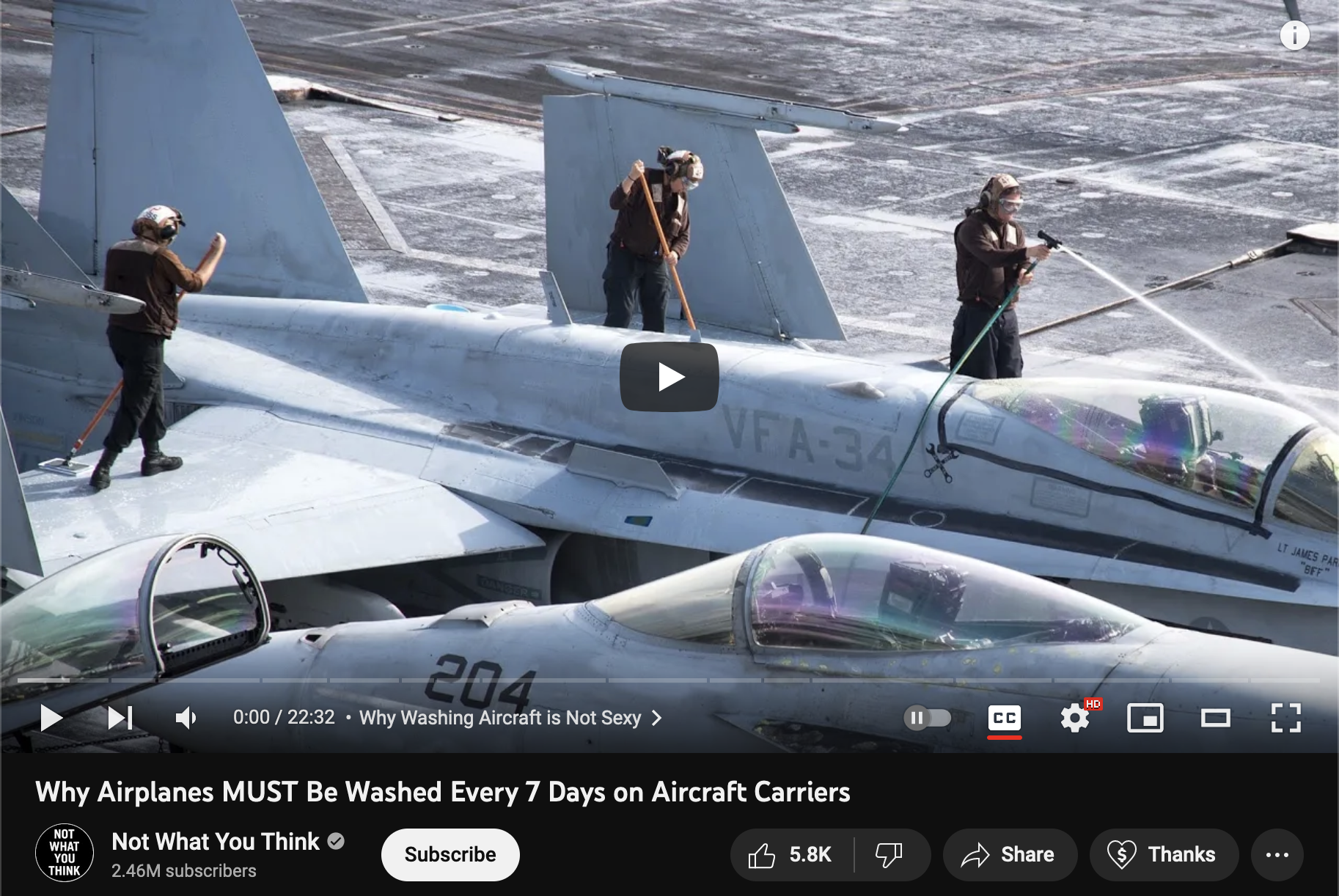
1. Import to Swell AI
First, import the video by pasting the YouTube URL into your project.
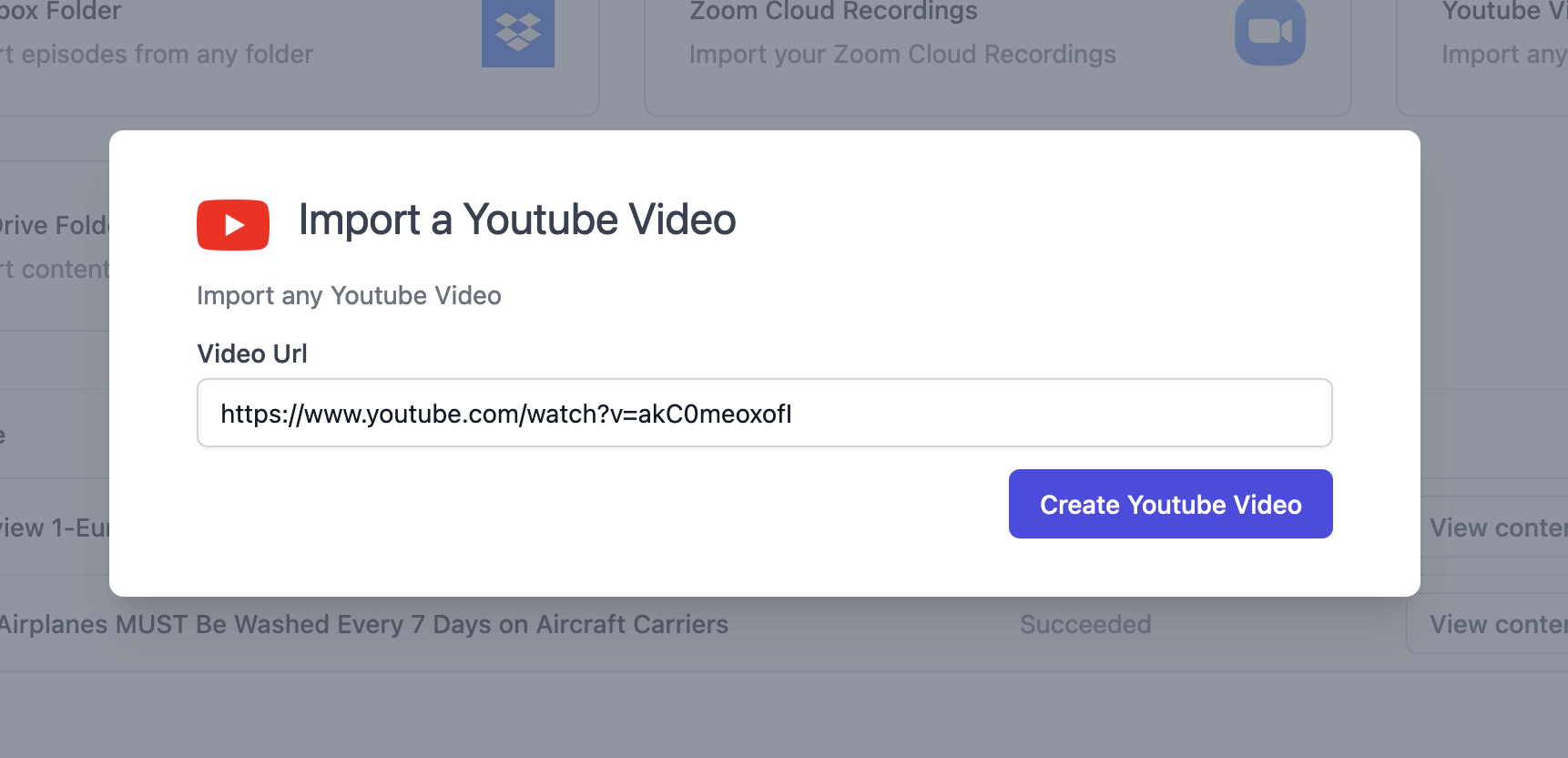
2. Receive Article
A few minutes later, you'll receive an article that's ready to publish. Preview the article here.
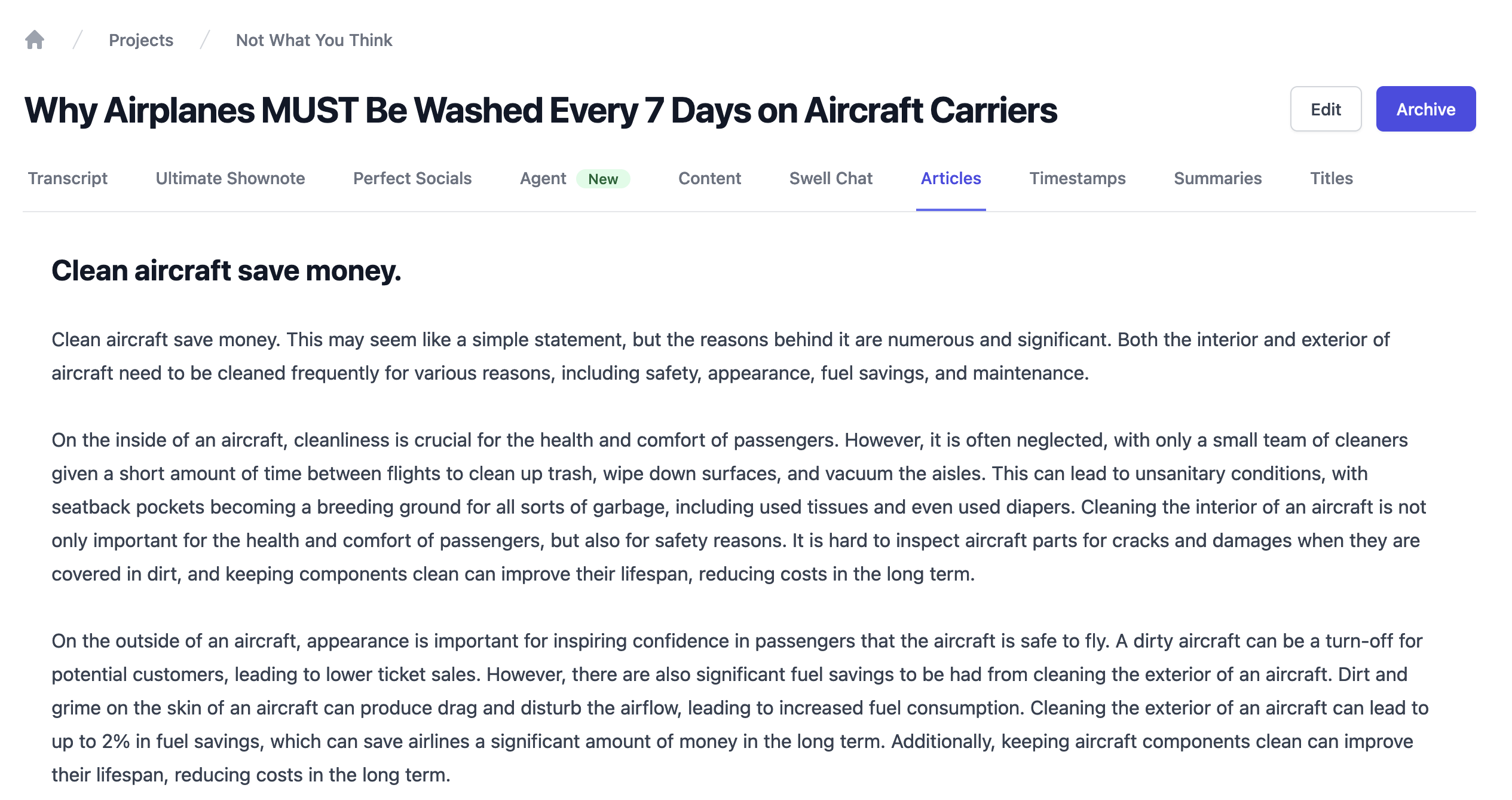
Testimonials
We have worked with thousands of amazing businesses
“Done! Seriously, this is an amazing product and is going to save us so much time. I will definitely be talking about it to others! With all the hype about Chat GPT, I think people are searching for the possibilities. And I have not found anything else that has these features. Fantastic!”

“This is an incredible service. What a game changer. Please keep working on it and improving it. Bands have roadies and A.I. like Swell is just a digital roadie and the rest is up to me; I gotta deliver a good show; I still gotta write hits. Roadies just make life better. THANK YOU.”

“It's honestly magic. We use this for podcast post-production and content writing. What people normally have a team for, one person can do easily. We take Swell's outputs and have our writer repurpose the content.”

“This is wonderful. Thank you so much for your help! SwellAI has been an integral part of my podcast workflow and Im glad that the customer service matches the actual service! Thank you again.”

“Your app is amazing and will be a huge asset for my business.”

“We had a backlog of podcasts that I've been wanting to get written up. I had my team just copy the YouTube URLs into Swell and it generated all the articles. We did in a day what would have taken us three months.”

“You all are amazing I am so thankful for Swell!!! you have made content creations more fun! Thank you”

- words written in 2023
- 130 million
- episodes uploaded
- 50k
- hours of media
- 30k
- answers by Swell Chat
- 20.5k
Finally, everything in one place...
Our writing platform is flexible and powerful
We have built a writing tool that is flexible enough to handle any type of content. Whether you are writing video descriptions, transcripts, blog posts, or even a book, we have you covered.
- 📝 YouTube Desciption
- Our AI video descriptions writes detailed summaries, time-stamps, key topics and more so you spend less time doing video SEO.
- ⏱ Transcripts
- Transcripts for your content to easily go to specific sections to get more context or find more quotes.
- 📚 Articles
- Long-format detailed articles written in the tone of the video. Formatted for readability and SEO ready to publish to your blog.
- 🎬 Video Summaries
- Detailed AI video summaries that include the contents referenced keywords. Built to rank your content better wherever you publish it.
- 💼 LinkedIn Posts
- Get detailed LinkedIn posts about your episode so you're always a thought leader.
- 🧵 Twitter Threads
- Twitter threads with the core ideas to get more listens to the episode.
- 📺 Social posts
- Get LinkedIn posts, Twitter threads, Instagram captions and more for your video. Easily drop into a Canva template or paste into your social media scheduling app.
- 🏷 Titles
- Get a list of titles and select your favorite. Makes brainstorming easy as cake.
Want product news and updates?
Sign up for our newsletter.
We do more than just content...
Build chat bots for your YouTube videos
Every uploaded video comes with a trained chat bot that your audience can engage with.
Integrations for every workflow
We easily fit into you or your team's production workflow. Nothing new to learn, so much to gain.

Apple Podcast

YouTube Video

RSS Feed

Zoom Cloud

Dropbox Folder

Google Drive

One Drive

Webhook

REST API
Produce faster
An Enterprise API
We've built an API that allows you to scale your podcast production workflow.
- Template driven
- Inspired by Sendgrid, Mailchimp, and Postmark, we allow you to create and apply templated content to your media.
- Simple, REST
- A simple REST API that allows you to create, generate, and manage your content.
- Developer friendly
- Documented and easy to use, we make it easy to integrate with your existing workflow.
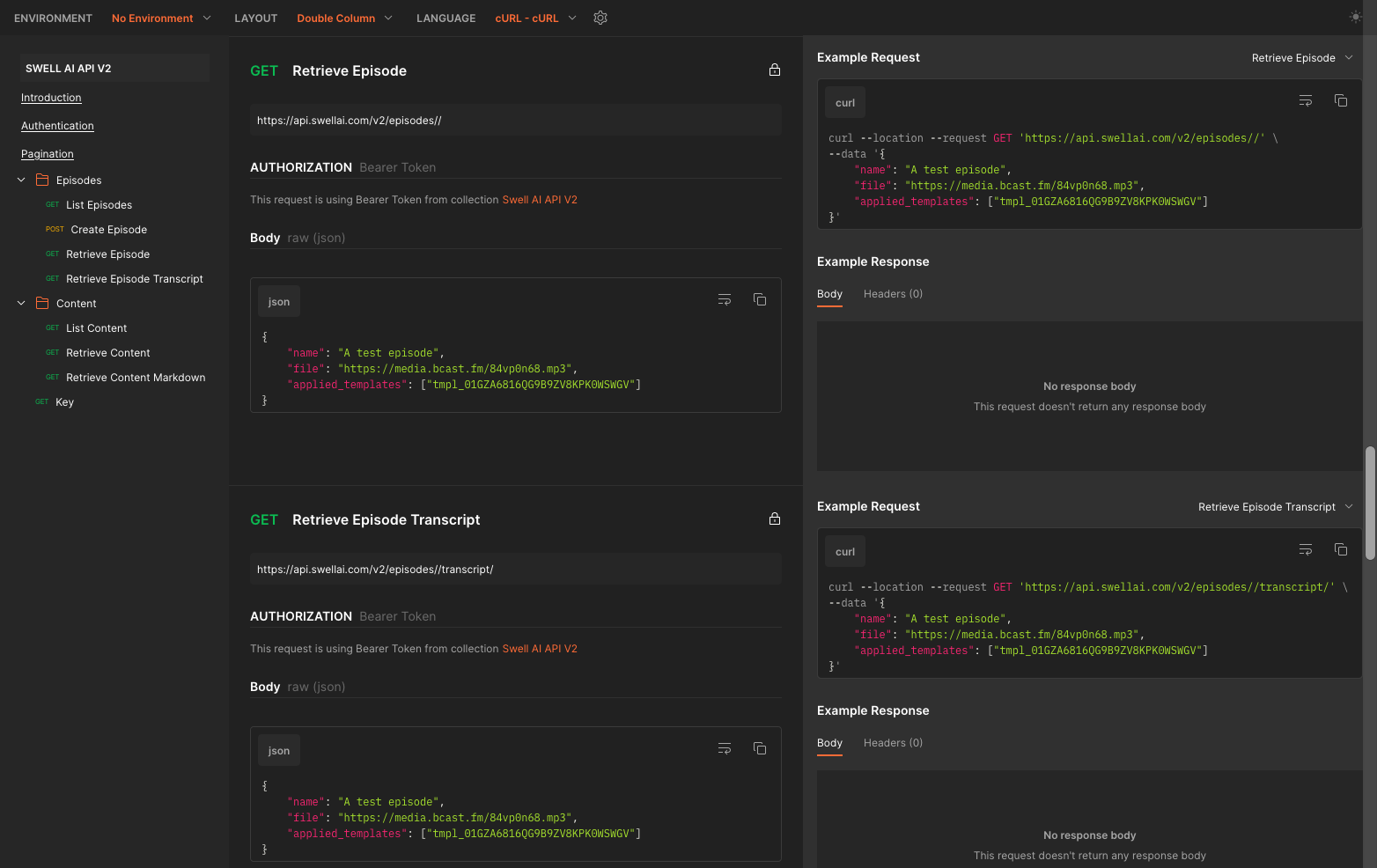
Easily manage multiple podcasts in one dashboard
Built for productivity
Create projects for each podcast you manage. Have unique integrations for every podcast. Keep your team organized and your content engine turning.
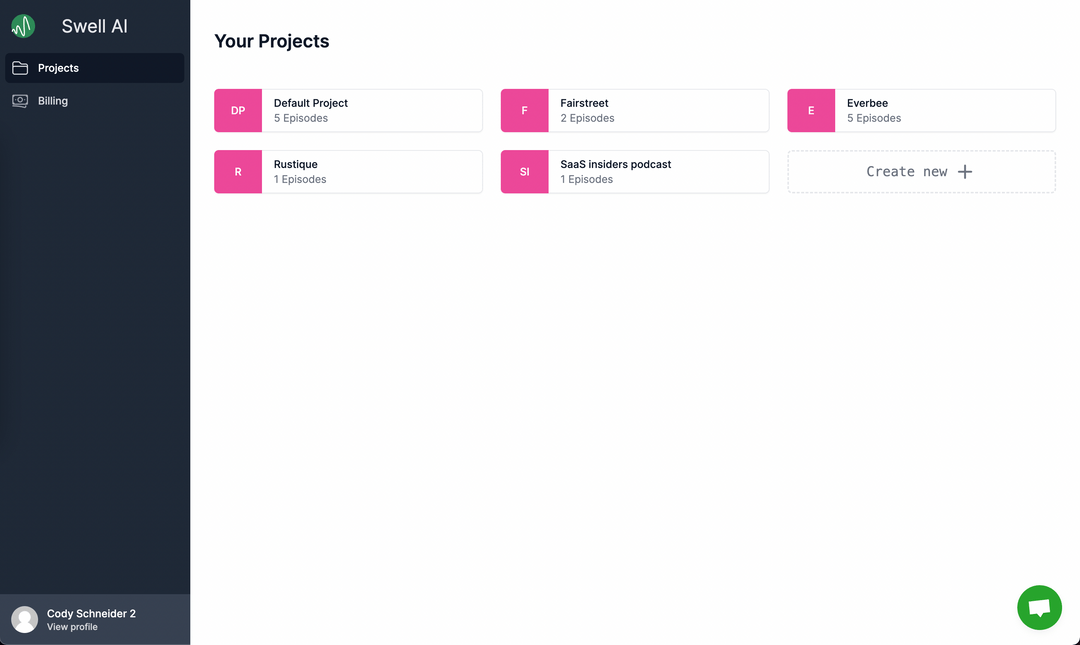
Bulk import and backfill
Import your existing catalog
Connect your RSS Feed or Apple Podcast and select which episodes you want imported. Get detailed show notes, articles, and whatever else you want written about each episode. Easily export all content files to Google Drive or Dropbox so you can share with your team.
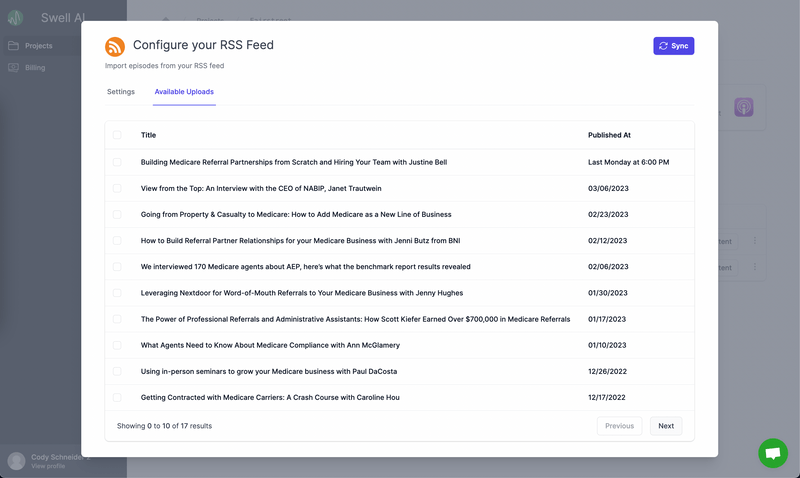
Pricing
Pricing for all production needs
Cancel at any time. 100% no questions asked refunds. Message us for high volume custom pricing.
Hobby
Try us at no cost
$0/mo
1 uploads($0.000/upload)
Choose Plan
What's included
- 1 upload a month
- Swell ChatGPT
- Sources & Destinations
- Clips with watermark
- Documents & Templates
- Generative titles, summaries, shownotes, speaker bio's, keywords, entities and blog posts
- Over 100 supported languages
Starter
$17/mo
3 hours(0.097/min)
What's included
- Swell ChatGPT
- Sources & Destinations
- No watermark on clips
- Documents & Templates
- Generative titles, summaries, shownotes, speaker bio's, keywords, entities and blog posts
- Over 100 supported languages
- Premium Customer Support
Enterprise
Everything you need
Everything and...
- API Access
- 99.99% SLA uptime
- Custom pricing tier
- Priority feature requests
- Access to custom onboarding, education and a dedicated account manager
- Enterprise-grade security with SSO, advanced privacy controls and SCIM
- Robust workspace visibility and control with audit logs, content activity reports, and data retention policies



